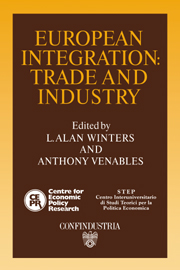Book contents
- Frontmatter
- Contents
- List of figures
- List of tables
- Preface
- Acknowledgements
- List of conference participants
- 1 European integration: trade and industry
- 2 Completing the internal market in the EC: factor demands and comparative advantage
- Discussion
- 3 External effects and Europe's integration
- Discussion
- 4 The quality and production of textiles and clothing and the completion of the internal market
- Discussion
- 5 Competition and imports in the European market
- Discussion
- 6 The structure and determinants of East–West trade: a preliminary analysis of the manufacturing sector
- Discussion
- 7 1992 and EFTA
- Discussion
- 8 Technology policy in the completed European market
- Discussion
- 9 Corporation tax, foreign direct investment and the single market
- Discussion
- 10 Japanese direct manufacturing investment in Europe
- Discussion
- Index
Discussion
Published online by Cambridge University Press: 07 September 2010
- Frontmatter
- Contents
- List of figures
- List of tables
- Preface
- Acknowledgements
- List of conference participants
- 1 European integration: trade and industry
- 2 Completing the internal market in the EC: factor demands and comparative advantage
- Discussion
- 3 External effects and Europe's integration
- Discussion
- 4 The quality and production of textiles and clothing and the completion of the internal market
- Discussion
- 5 Competition and imports in the European market
- Discussion
- 6 The structure and determinants of East–West trade: a preliminary analysis of the manufacturing sector
- Discussion
- 7 1992 and EFTA
- Discussion
- 8 Technology policy in the completed European market
- Discussion
- 9 Corporation tax, foreign direct investment and the single market
- Discussion
- 10 Japanese direct manufacturing investment in Europe
- Discussion
- Index
Summary
In introducing his theoretical analysis of ‘technology policy’, David Ulph observes the potential inconsistency between the objectives of a more competitive post-1992 single European market and government sponsored cooperative ventures aimed at bridging the ‘technology gap’ between European and foreign producers. Gains are posited from a more competitive market environment, together with prospective gains from cooperation in R & D among the same agents who in their product-market guise are to be competitors. Since resources are bounded, government (or the supranational authorities) may be obliged to ‘target’ firms for assistance in R & D joint ventures. Against this background, David Ulph asks: Is a policy goal of ‘technological leadership’ an appropriate welfare objective? And under what circumstances is there a case for government assistance to facilitate cooperation in R & D activities? In turn, if an interventionist role for government can be demonstrated in a particular instance, how can a policy be designed that ensures ‘optimal’ cooperation among firms?
These questions bring us to the heart of ‘technology policy’. In order to seek answers, David Ulph formulates a Cournot-Nash model of an industry wherein firms produce a homogenous product; the industry consists of designated numbers of ‘European’ and ‘Japanese’ firms selling in an integrated (non-segmented) international market. Firms are portrayed as independently choosing their profit-maximising outputs, and as making R & D outlays that reduce costs of production. Technological spillovers are absent – that is, firms can be excluded from the benefits of investments that they did not undertake. All firms confront identical R & D technologies, in the sense of opportunities for investments that will with certainty reduce costs of production.
- Type
- Chapter
- Information
- European IntegrationTrade and Industry, pp. 161 - 164Publisher: Cambridge University PressPrint publication year: 1991

